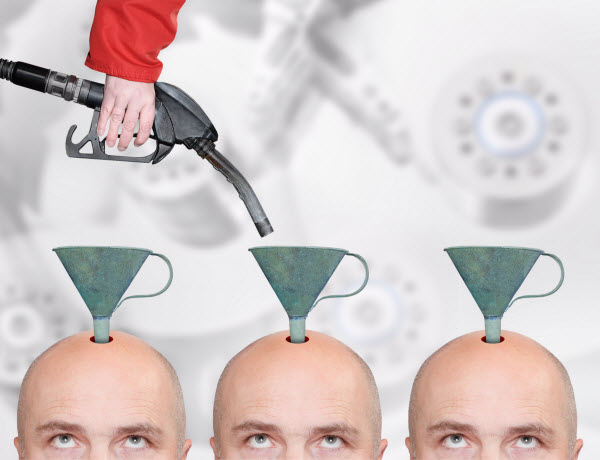It has been my experience that customer service and marketing departments often exist in separate silos in many organisations.
 For marketers, this is a missed opportunity.
For marketers, this is a missed opportunity.
Customer service agents work at the coal face, interacting with customers on a daily basis and can bring great customer insights to the marketing team, helping them understand their target market better (think buyer personas).
As marketers we are always looking for content and there is no better source of content than real life stories from your customer base.
There is another reason. Customer Loyalty.
When I work with clients I often talk about the lifetime value of a new customer or client.
There is often significant cost in landing a new customer so retention is important. It’s not just about that first sale, but subsequent sales over a number of years.
For FMCG clients it’s not just the initial five-euro sale – It’s about getting on the customers shopping list so the five-euro sale happens 4 times a month, 52 times a year for 10 years – That’s a much healthier ROI!
So what is customer loyalty and how do we influence it?
I recently read an article by A.G. Lafley and Roger L. Martin, called Customer Loyalty Is Overrated, which helped me understand that customer loyalty has a lot to do with the subconscious.

The following excerpt is the culprit of my aha! moment on the truth about customer loyalty:
Research into the workings of the human brain suggests that the mind loves automaticity more than just about anything else—certainly more than engaging in conscious consideration. Given a choice, it would like to do the same things over and over again.
Now that I’ve read it, automaticity explains the things many of us do as creatures of habit.
Following the same routine in the morning.
Sticking to a singular meal at a favourite restaurant.
Doing anything we don’t enjoy because it’s easier than figuring out an alternative.
It’s even more obvious when you apply it to consumerism and marketing. I loved watching Mad Men on Netflix and one thing that struck me was the number of brands from the 60s and 70s that are still around.
Yet it makes sense. What do Clearasil, Right Guard, Vicks and Heineken all have in common? Even though many of us weren’t around when these products emerged, we know what they do and where to buy them.
Heineken, in all its green-bottled glory, has been quenching thirst for over 140 years. For many beer drinkers, buying a case of Heineken is more than automatic, it’s ritual.
If Right Guard has been helping athletes keep odour and sweat at bay since the 1960s, why buy anything else?
And Clearasil skincare products have been ridding teens of acne for 60 years. What’s the argument for not using Clearasil?
These brands and their products were go-to purchases for generations before us. Contrary to what most marketers believe, people still buy these products because it’s simple, and they don’t have a reason not to. Given their lasting popularity, the cycle of automaticity definitely remains unbroken.
But Wait, Does The Message Still Matter?
Sure, of course the message matters.
I’m a marketer, so I’m not discrediting the importance of a solid value proposition and the perfect marketing message. These are still the components of a company’s launching pad for its new product or service.
But a better question is: does the message fuel customer loyalty?
As Lafley and Martin point out, as long as a product meets customer expectations, the answer is no.
Think about it: when you go to the store to buy toothpaste, do you stop in the toothpaste aisle for five minutes and consider what to buy? Or do you grab the Colgate (or whichever brand you usually use)?
Colgate is prominently displayed and easy to access. It’s in the local store, big supermarket and even petrol stations. If Colgate has cleaned your teeth for years, chances are your subconscious wants to automatically grab the Colgate and move on.
While all this is happening, what looks like customer loyalty is actually the human brain doing the easiest thing possible.
Once a brand gets you on their track, they should be able to keep you there and the role of the marketing team is to keep the message relevant and current to stop the consumer turning to the next shiny object.
Conclusion
The truth about customer loyalty is that it’s rarely about loyalty.
In fact, the term might qualify as a misnomer given the way it’s used and understood.
Rather than customers making conscious choices to remain “loyal” to a brand or a business, their subconscious makes decisions for them. They aren’t complex decisions either, they’re simple ones based on accessibility and history with a product.
Think about your experiences with products and services. How often are you truly loyal to a product because of the brand behind it?
Is it more accurate to say you buy a product because you did the initial research, bought the product or service and found that it lived up to the promise?
For me, that’s often the case.
In fact, the only time a conscious decision takes place is when it’s to deliberately not remain loyal, which more often than not, is the result of a bad customer experience.
For customer service teams, there is a need to better understand your brand’s marketing strategy so it aligns with the customer experience.
Marketing and sales are selling the dream and customer service is often the customer’s first experience of the reality.
Think about your own organisation – Do they match?

Stay Connected